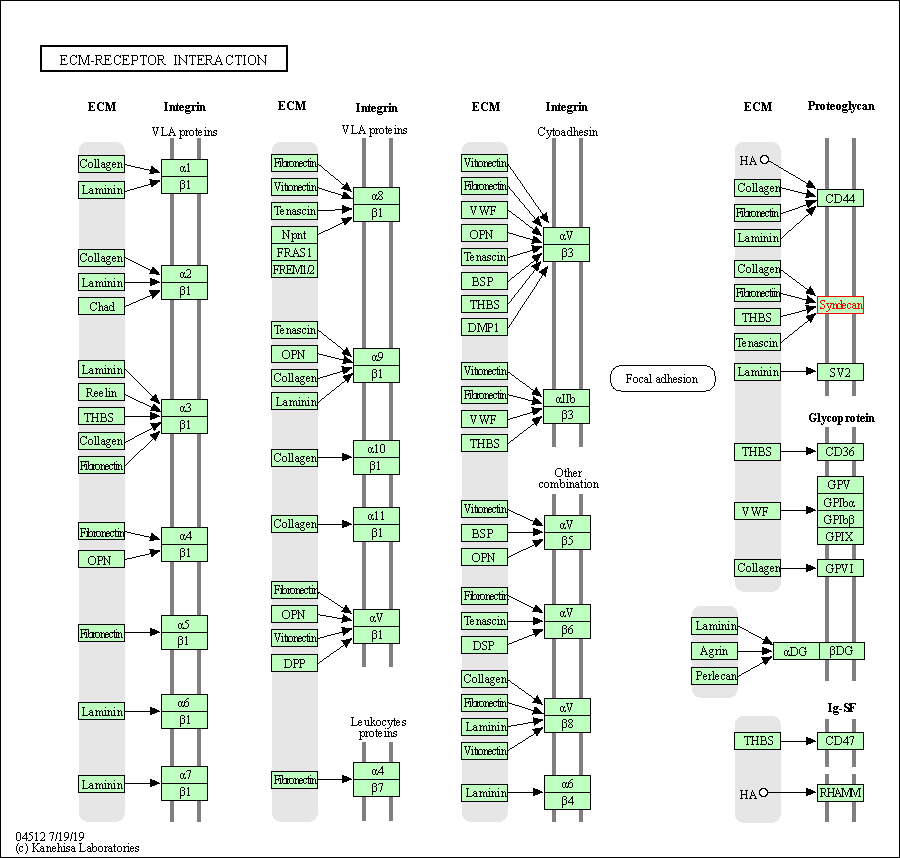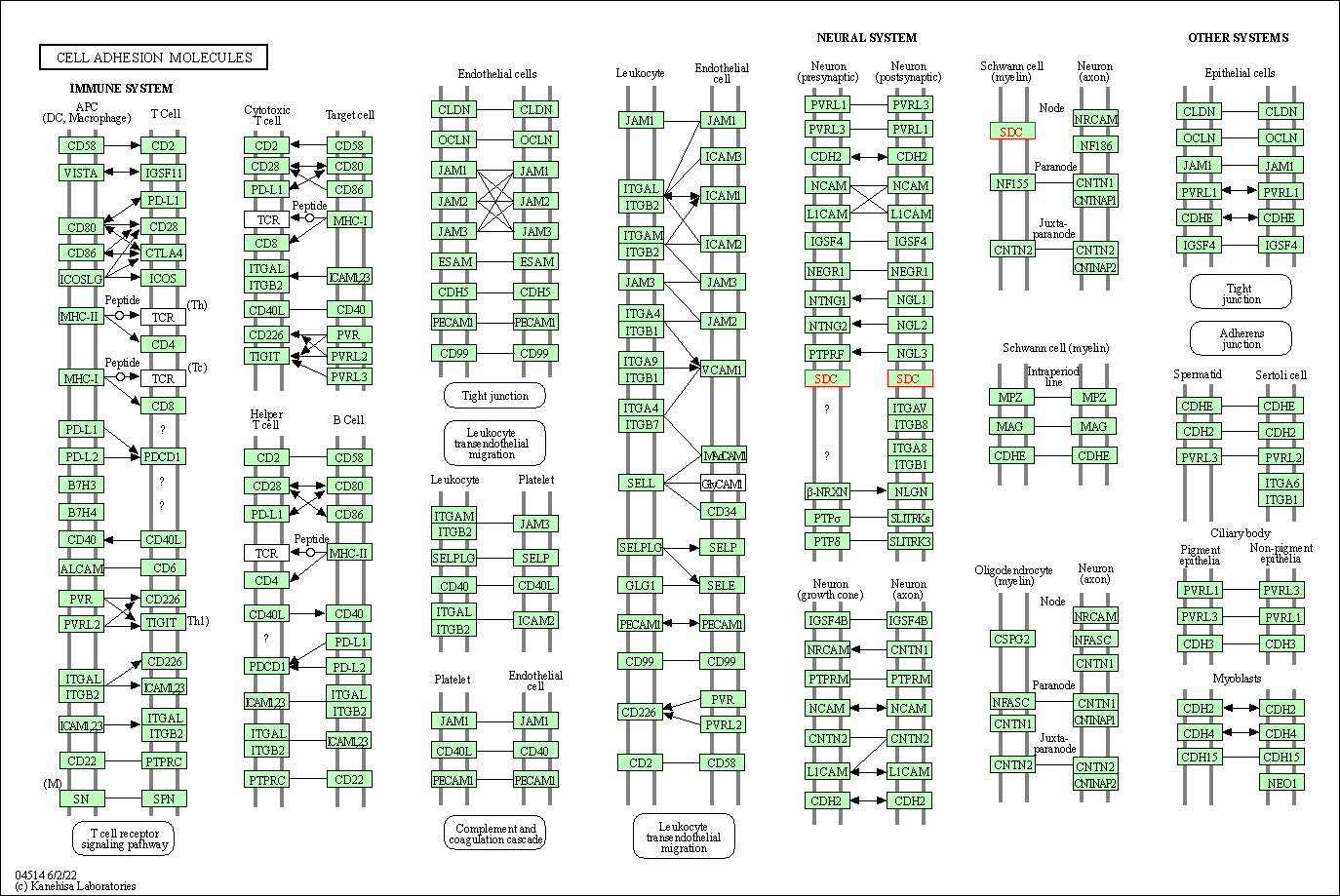Target Information
| Target General Information | Top | |||||
|---|---|---|---|---|---|---|
| Target ID |
T13017
(Former ID: TTDI02170)
|
|||||
| Target Name |
Syndecan-1 (SDC1)
|
|||||
| Synonyms |
SYND1; SDC; CD138
Click to Show/Hide
|
|||||
| Gene Name |
SDC1
|
|||||
| Target Type |
Clinical trial target
|
[1] | ||||
| Disease | [+] 2 Target-related Diseases | + | ||||
| 1 | Immune system disease [ICD-11: 4A01-4B41] | |||||
| 2 | Multiple myeloma [ICD-11: 2A83] | |||||
| Function |
Regulates exosome biogenesis in concert with SDCBP and PDCD6IP. Cell surface proteoglycan that bears both heparan sulfate and chondroitin sulfate and that links the cytoskeleton to the interstitial matrix.
Click to Show/Hide
|
|||||
| BioChemical Class |
Peptide translocating syndecan
|
|||||
| UniProt ID | ||||||
| Sequence |
MRRAALWLWLCALALSLQPALPQIVATNLPPEDQDGSGDDSDNFSGSGAGALQDITLSQQ
TPSTWKDTQLLTAIPTSPEPTGLEATAASTSTLPAGEGPKEGEAVVLPEVEPGLTAREQE ATPRPRETTQLPTTHLASTTTATTAQEPATSHPHRDMQPGHHETSTPAGPSQADLHTPHT EDGGPSATERAAEDGASSQLPAAEGSGEQDFTFETSGENTAVVAVEPDRRNQSPVDQGAT GASQGLLDRKEVLGGVIAGGLVGLIFAVCLVGFMLYRMKKKDEGSYSLEEPKQANGGAYQ KPTKQEEFYA Click to Show/Hide
|
|||||
| 3D Structure | Click to Show 3D Structure of This Target | AlphaFold | ||||
| Drugs and Modes of Action | Top | |||||
|---|---|---|---|---|---|---|
| Clinical Trial Drug(s) | [+] 6 Clinical Trial Drugs | + | ||||
| 1 | BT-062 | Drug Info | Phase 2 | Multiple myeloma | [2], [3] | |
| 2 | CART-138 cells | Drug Info | Phase 1/2 | Multiple myeloma | [4] | |
| 3 | CART-138 cells | Drug Info | Phase 1/2 | Multiple myeloma | [5] | |
| 4 | CD138 CAR T cells | Drug Info | Phase 1/2 | Multiple myeloma | [6] | |
| 5 | CAR138 T Cells | Drug Info | Phase 1 | Immune System disease | [7] | |
| 6 | CAR-T cells targeting CD138 | Drug Info | Clinical trial | Multiple myeloma | [8] | |
| Mode of Action | [+] 1 Modes of Action | + | ||||
| CAR-T-Cell-Therapy | [+] 5 CAR-T-Cell-Therapy drugs | + | ||||
| 1 | CART-138 cells | Drug Info | [4] | |||
| 2 | CART-138 cells | Drug Info | [5] | |||
| 3 | CD138 CAR T cells | Drug Info | [6] | |||
| 4 | CAR138 T Cells | Drug Info | [7] | |||
| 5 | CAR-T cells targeting CD138 | Drug Info | [8] | |||
| Cell-based Target Expression Variations | Top | |||||
|---|---|---|---|---|---|---|
| Cell-based Target Expression Variations | ||||||
| Drug Binding Sites of Target | Top | |||||
|---|---|---|---|---|---|---|
| Ligand Name: Phosphonotyrosine | Ligand Info | |||||
| Structure Description | Crystal Structure of T-cell Lymphoma Invasion and Metastasis-1 PDZ in complex with phosphorylated Syndecan1 Peptide | PDB:4GVC | ||||
| Method | X-ray diffraction | Resolution | 1.54 Å | Mutation | No | [9] |
| PDB Sequence |
TKQEEFA
|
|||||
|
|
||||||
| Ligand Name: 5-(Dimethylamino)naphthalene-1-sulfonic acid | Ligand Info | |||||
| Structure Description | Crystal Structure of T-cell Lymphoma Invasion and Metastasis-1 PDZ in complex with phosphorylated Syndecan1 Peptide | PDB:4GVC | ||||
| Method | X-ray diffraction | Resolution | 1.54 Å | Mutation | No | [9] |
| PDB Sequence |
TKQEEFA
|
|||||
|
|
||||||
| Click to View More Binding Site Information of This Target and Ligand Pair | ||||||
| Click to View More Binding Site Information of This Target with Different Ligands | ||||||
| Different Human System Profiles of Target | Top |
|---|---|
|
Human Similarity Proteins
of target is determined by comparing the sequence similarity of all human proteins with the target based on BLAST. The similarity proteins for a target are defined as the proteins with E-value < 0.005 and outside the protein families of the target.
A target that has fewer human similarity proteins outside its family is commonly regarded to possess a greater capacity to avoid undesired interactions and thus increase the possibility of finding successful drugs
(Brief Bioinform, 21: 649-662, 2020).
Human Tissue Distribution
of target is determined from a proteomics study that quantified more than 12,000 genes across 32 normal human tissues. Tissue Specificity (TS) score was used to define the enrichment of target across tissues.
The distribution of targets among different tissues or organs need to be taken into consideration when assessing the target druggability, as it is generally accepted that the wider the target distribution, the greater the concern over potential adverse effects
(Nat Rev Drug Discov, 20: 64-81, 2021).
Human Pathway Affiliation
of target is determined by the life-essential pathways provided on KEGG database. The target-affiliated pathways were defined based on the following two criteria (a) the pathways of the studied target should be life-essential for both healthy individuals and patients, and (b) the studied target should occupy an upstream position in the pathways and therefore had the ability to regulate biological function.
Targets involved in a fewer pathways have greater likelihood to be successfully developed, while those associated with more human pathways increase the chance of undesirable interferences with other human processes
(Pharmacol Rev, 58: 259-279, 2006).
Biological Network Descriptors
of target is determined based on a human protein-protein interactions (PPI) network consisting of 9,309 proteins and 52,713 PPIs, which were with a high confidence score of ≥ 0.95 collected from STRING database.
The network properties of targets based on protein-protein interactions (PPIs) have been widely adopted for the assessment of target’s druggability. Proteins with high node degree tend to have a high impact on network function through multiple interactions, while proteins with high betweenness centrality are regarded to be central for communication in interaction networks and regulate the flow of signaling information
(Front Pharmacol, 9, 1245, 2018;
Curr Opin Struct Biol. 44:134-142, 2017).
Human Similarity Proteins
Human Tissue Distribution
Human Pathway Affiliation
Biological Network Descriptors
|
|
|
There is no similarity protein (E value < 0.005) for this target
|
|
Note:
If a protein has TS (tissue specficity) scores at least in one tissue >= 2.5, this protein is called tissue-enriched (including tissue-enriched-but-not-specific and tissue-specific). In the plots, the vertical lines are at thresholds 2.5 and 4.
|


| KEGG Pathway | Pathway ID | Affiliated Target | Pathway Map |
|---|---|---|---|
| ECM-receptor interaction | hsa04512 | Affiliated Target |

|
| Class: Environmental Information Processing => Signaling molecules and interaction | Pathway Hierarchy | ||
| Cell adhesion molecules | hsa04514 | Affiliated Target |

|
| Class: Environmental Information Processing => Signaling molecules and interaction | Pathway Hierarchy | ||
| Degree | 27 | Degree centrality | 2.90E-03 | Betweenness centrality | 2.24E-03 |
|---|---|---|---|---|---|
| Closeness centrality | 2.34E-01 | Radiality | 1.41E+01 | Clustering coefficient | 6.84E-02 |
| Neighborhood connectivity | 1.90E+01 | Topological coefficient | 5.72E-02 | Eccentricity | 12 |
| Download | Click to Download the Full PPI Network of This Target | ||||
| Target Regulators | Top | |||||
|---|---|---|---|---|---|---|
| Target-regulating microRNAs | ||||||
| Target Profiles in Patients | Top | |||||
|---|---|---|---|---|---|---|
| Target Expression Profile (TEP) |
||||||
| Target Affiliated Biological Pathways | Top | |||||
|---|---|---|---|---|---|---|
| PID Pathway | [+] 5 PID Pathways | + | ||||
| 1 | Beta3 integrin cell surface interactions | |||||
| 2 | Integrins in angiogenesis | |||||
| 3 | Proteoglycan syndecan-mediated signaling events | |||||
| 4 | Syndecan-1-mediated signaling events | |||||
| 5 | Beta5 beta6 beta7 and beta8 integrin cell surface interactions | |||||
| References | Top | |||||
|---|---|---|---|---|---|---|
| REF 1 | The monoclonal antibody nBT062 conjugated to cytotoxic Maytansinoids has selective cytotoxicity against CD138-positive multiple myeloma cells in vitro and in vivo. Clin Cancer Res. 2009 Jun 15;15(12):4028-37. | |||||
| REF 2 | Clinical pipeline report, company report or official report of the Pharmaceutical Research and Manufacturers of America (PhRMA) | |||||
| REF 3 | Clinical pipeline report, company report or official report of the Pharmaceutical Research and Manufacturers of America (PhRMA) | |||||
| REF 4 | ClinicalTrials.gov (NCT01886976) Treatment of Chemotherapy Refractory Multiple Myeloma by CART-138 | |||||
| REF 5 | ClinicalTrials.gov (NCT03196414) Study of CART-138/BCMA Therapy for R/R Multiple Myeloma | |||||
| REF 6 | ClinicalTrials.gov (NCT03271632) Multi-CAR T Cell Therapy in the Treatment of Multiple Myeloma | |||||
| REF 7 | ClinicalTrials.gov (NCT03672318) Study of ATLCAR.CD138 Cells for Relapsed/Refractory Multiple Myeloma | |||||
| REF 8 | ClinicalTrials.gov (NCT03473496) CAR-T Cells Therapy in Relapsed/Refractory Multiple Myeloma | |||||
| REF 9 | The structure of the Tiam1 PDZ domain/ phospho-syndecan1 complex reveals a ligand conformation that modulates protein dynamics. Structure. 2013 Mar 5;21(3):342-54. | |||||
If You Find Any Error in Data or Bug in Web Service, Please Kindly Report It to Dr. Zhou and Dr. Zhang.

